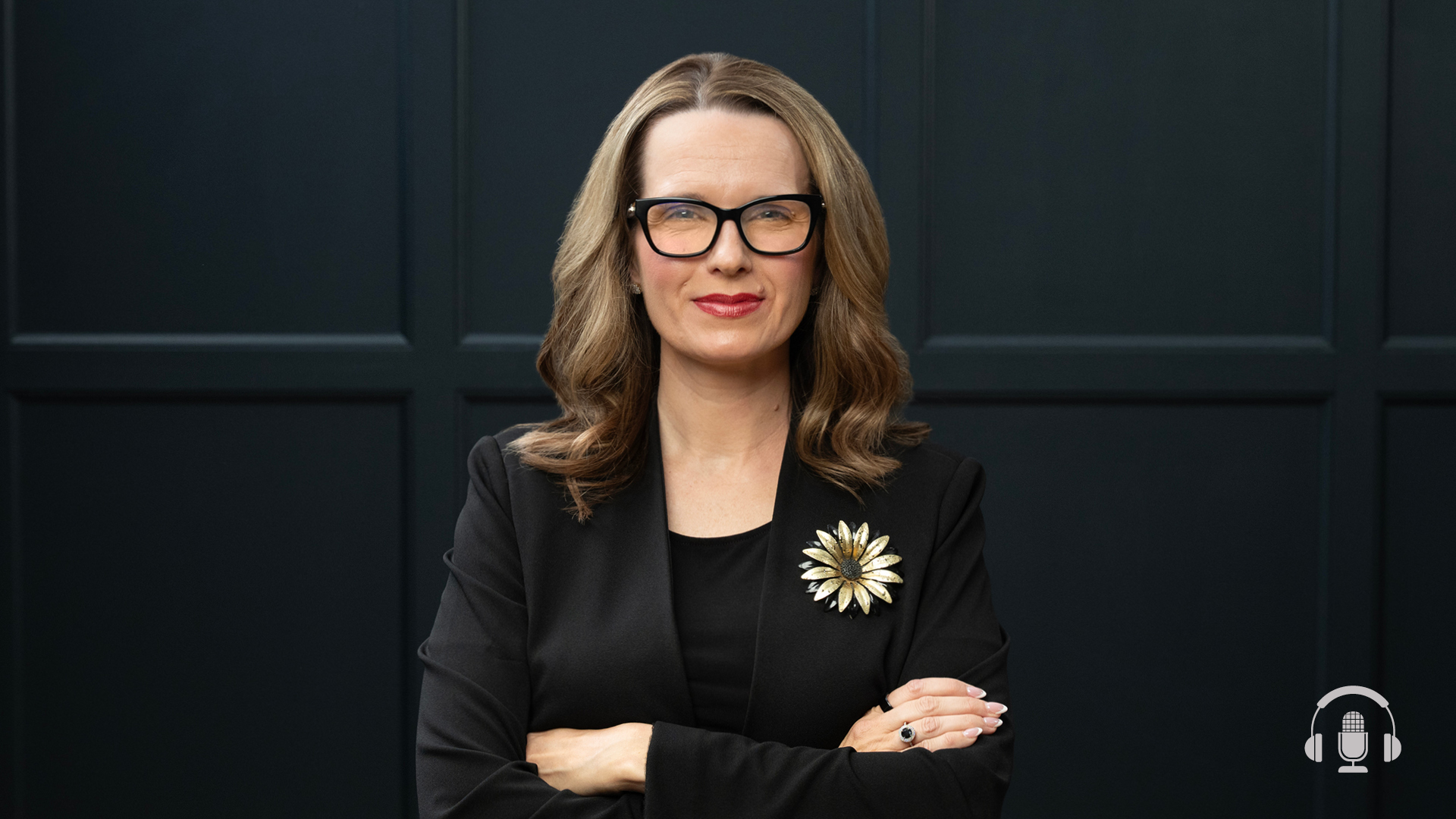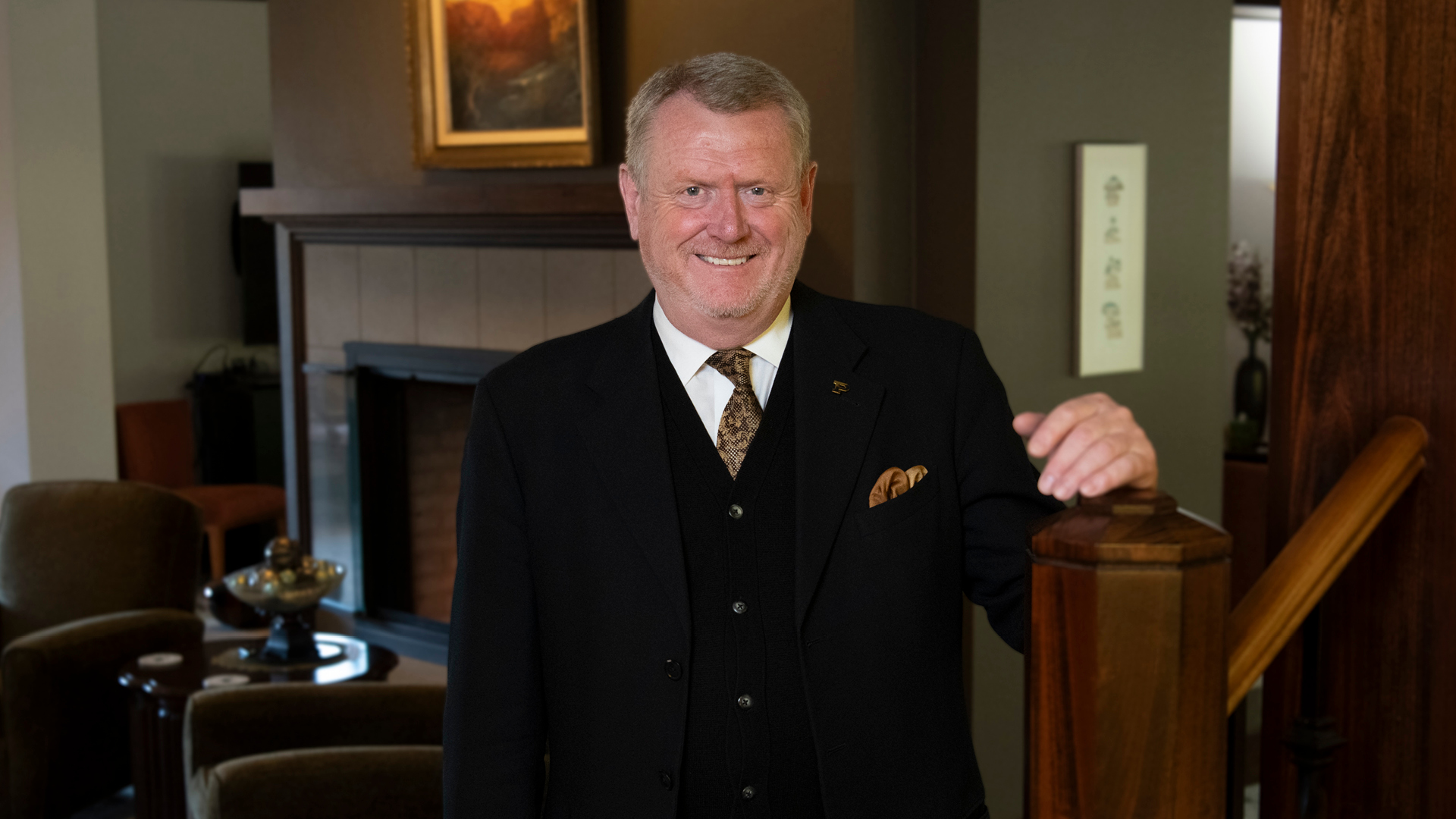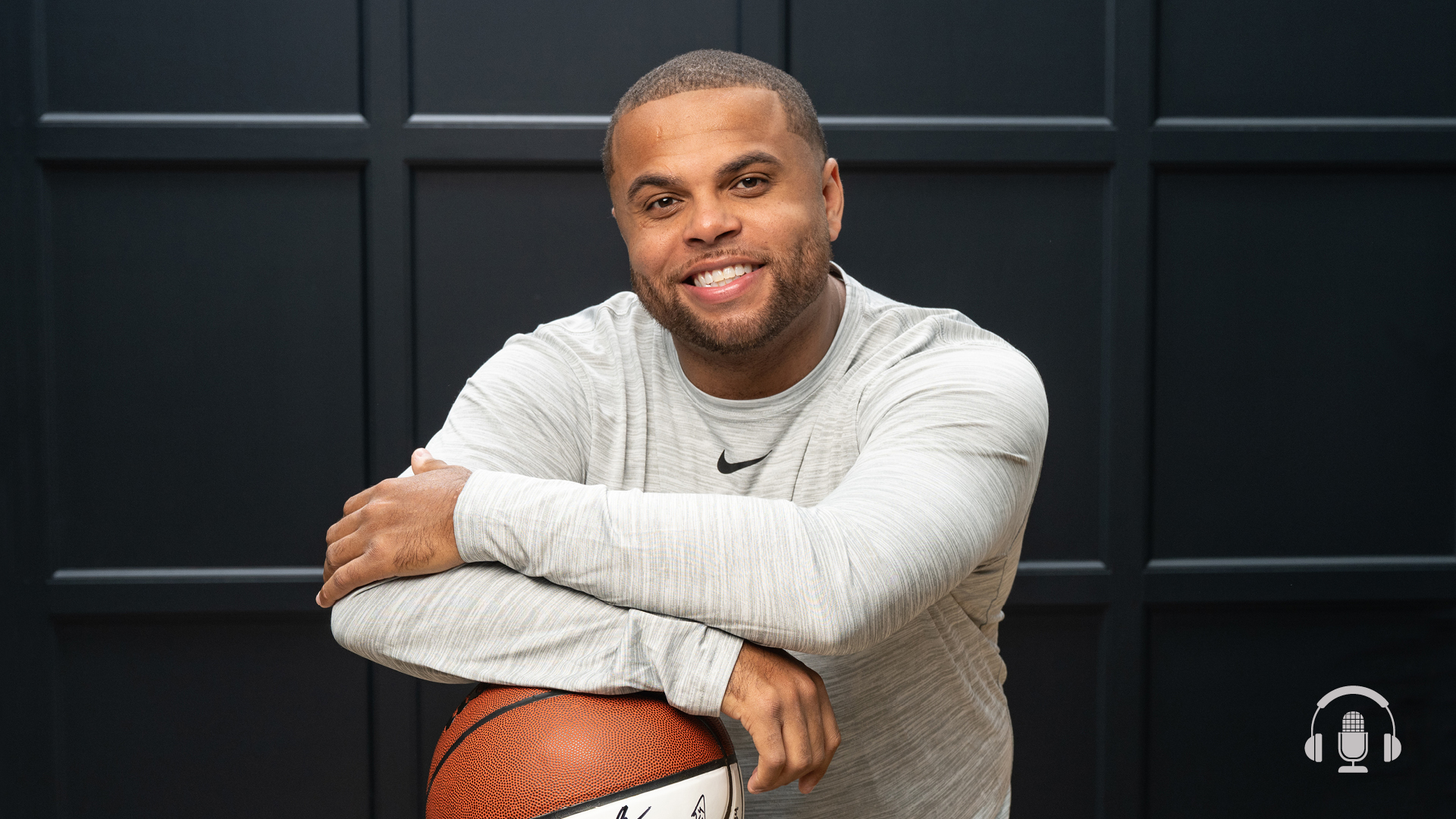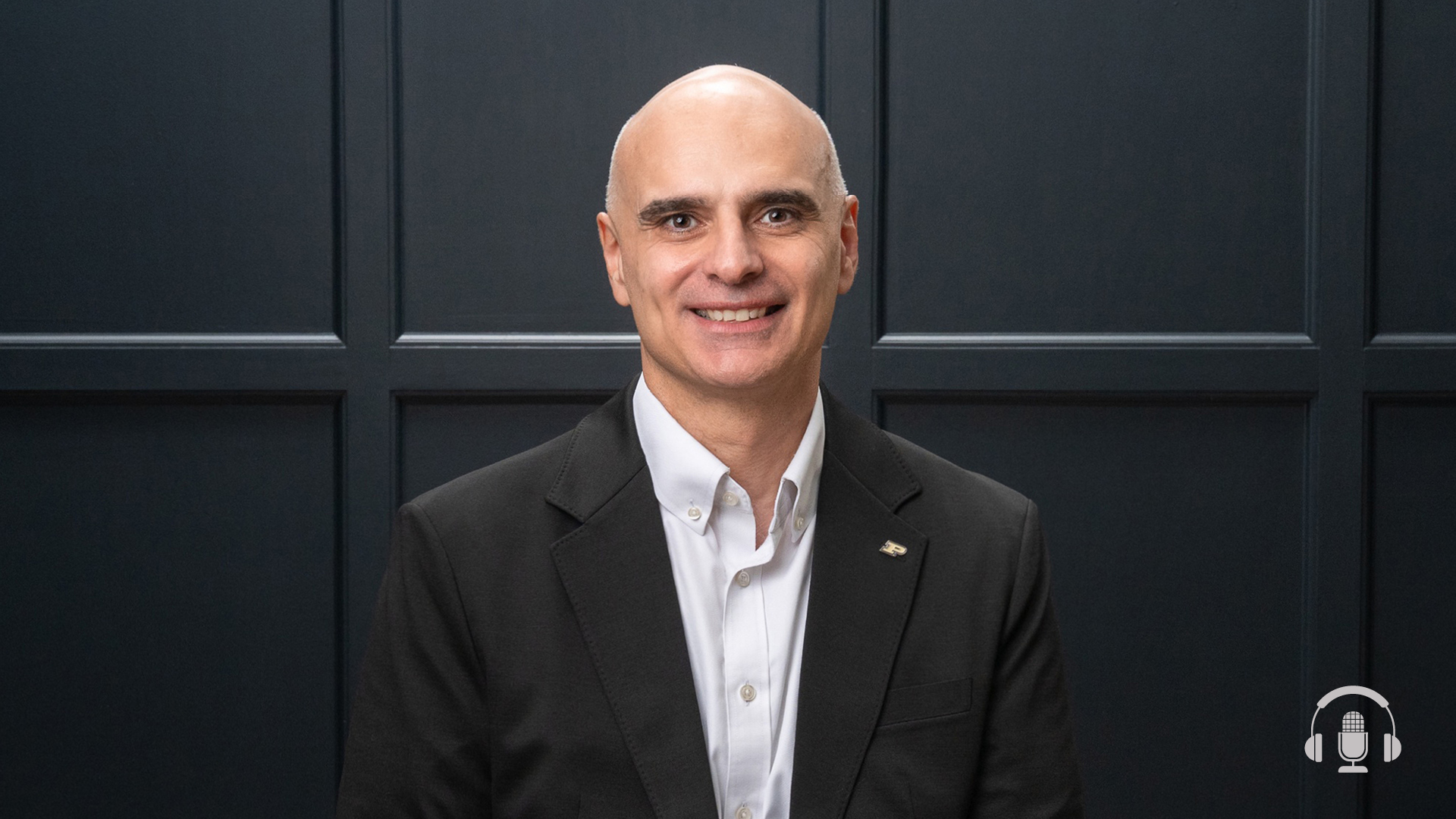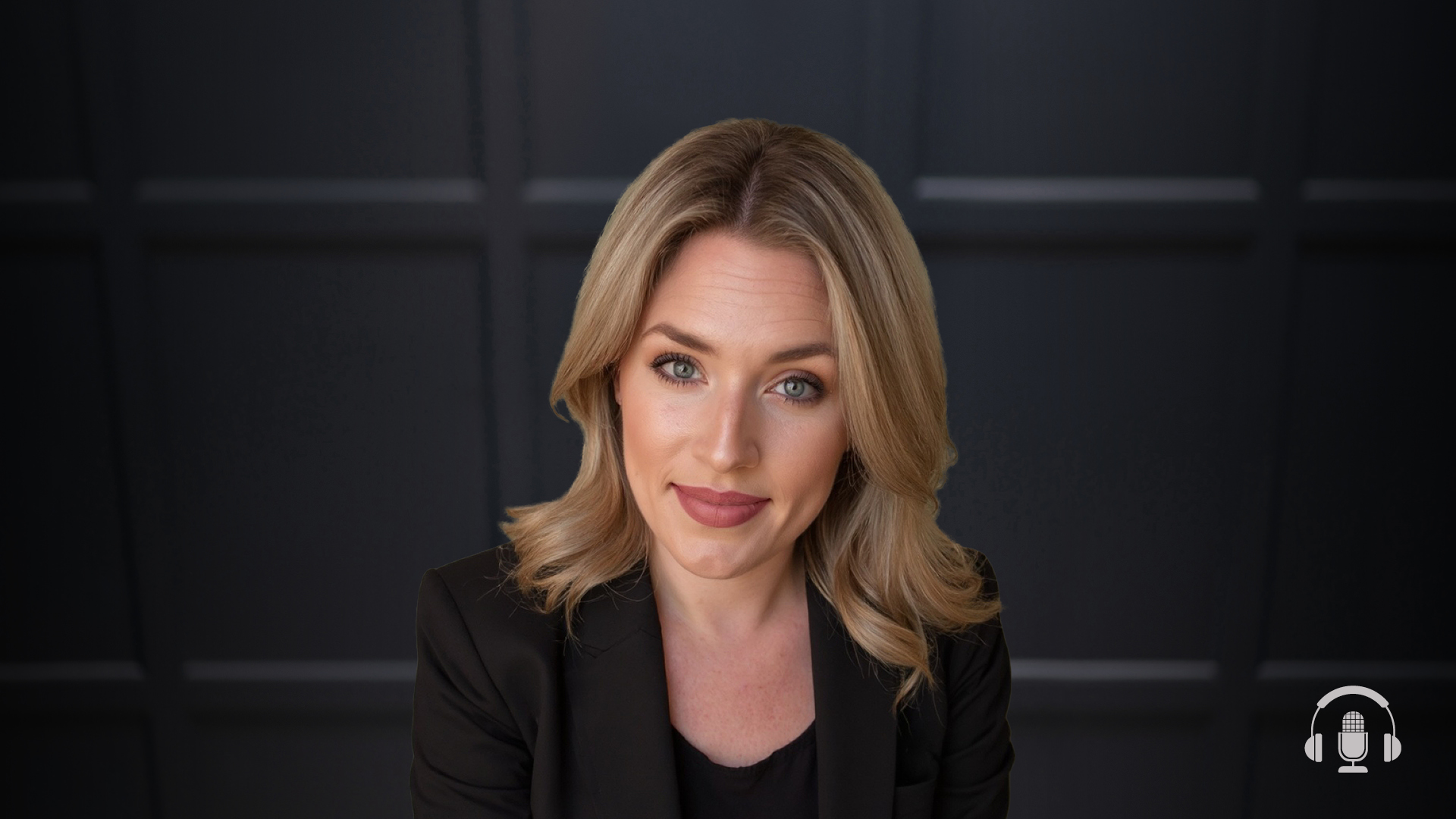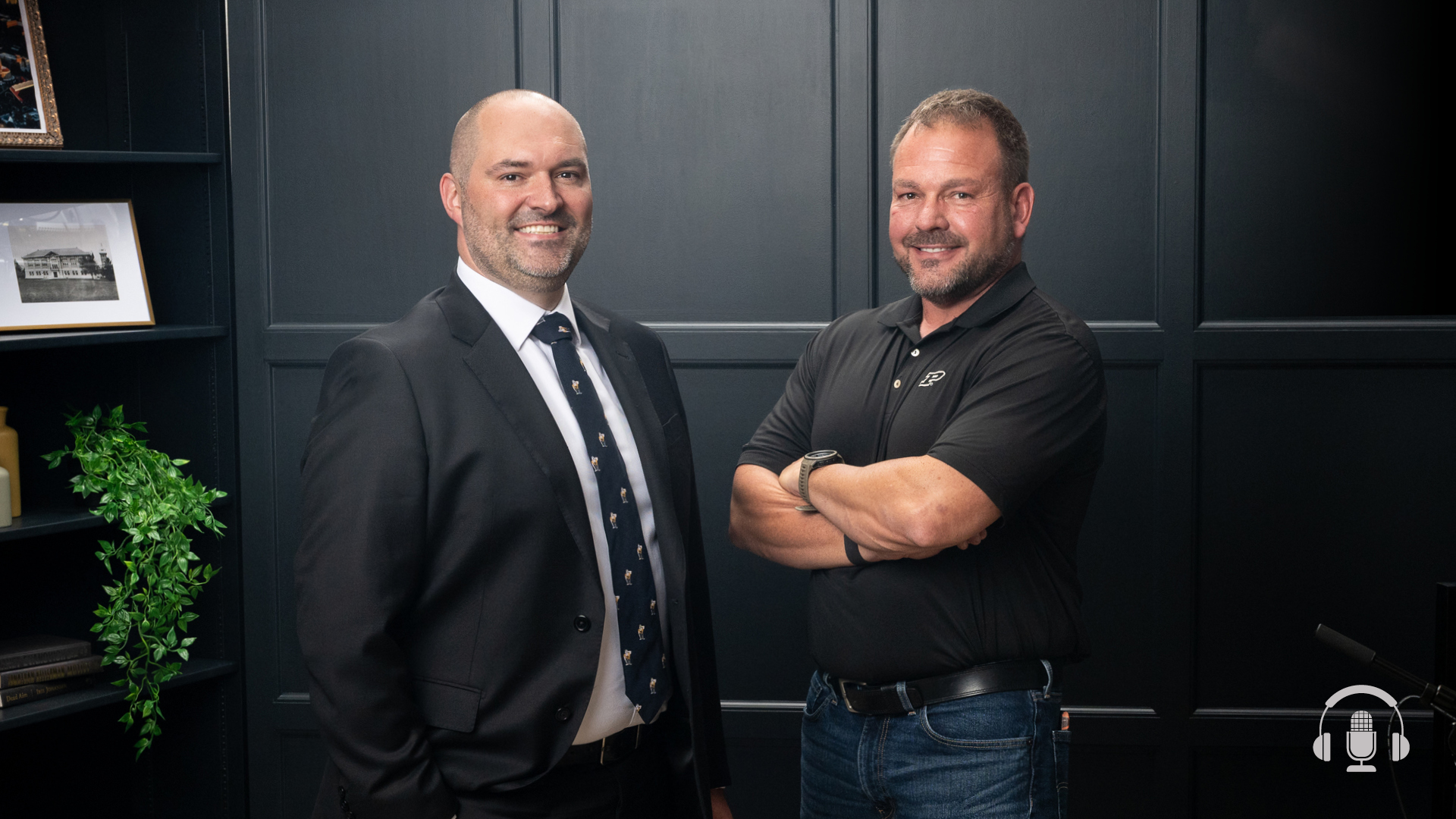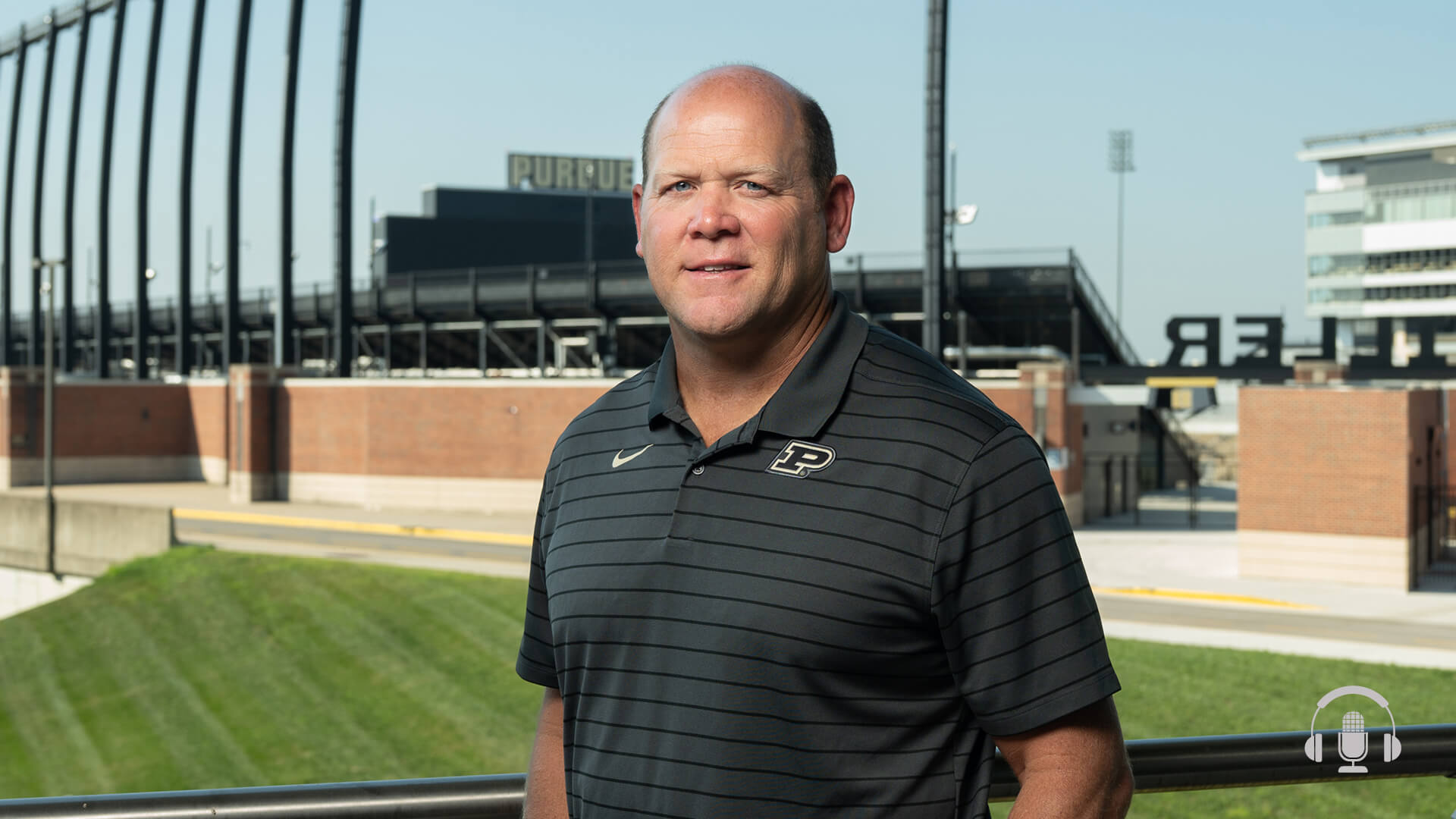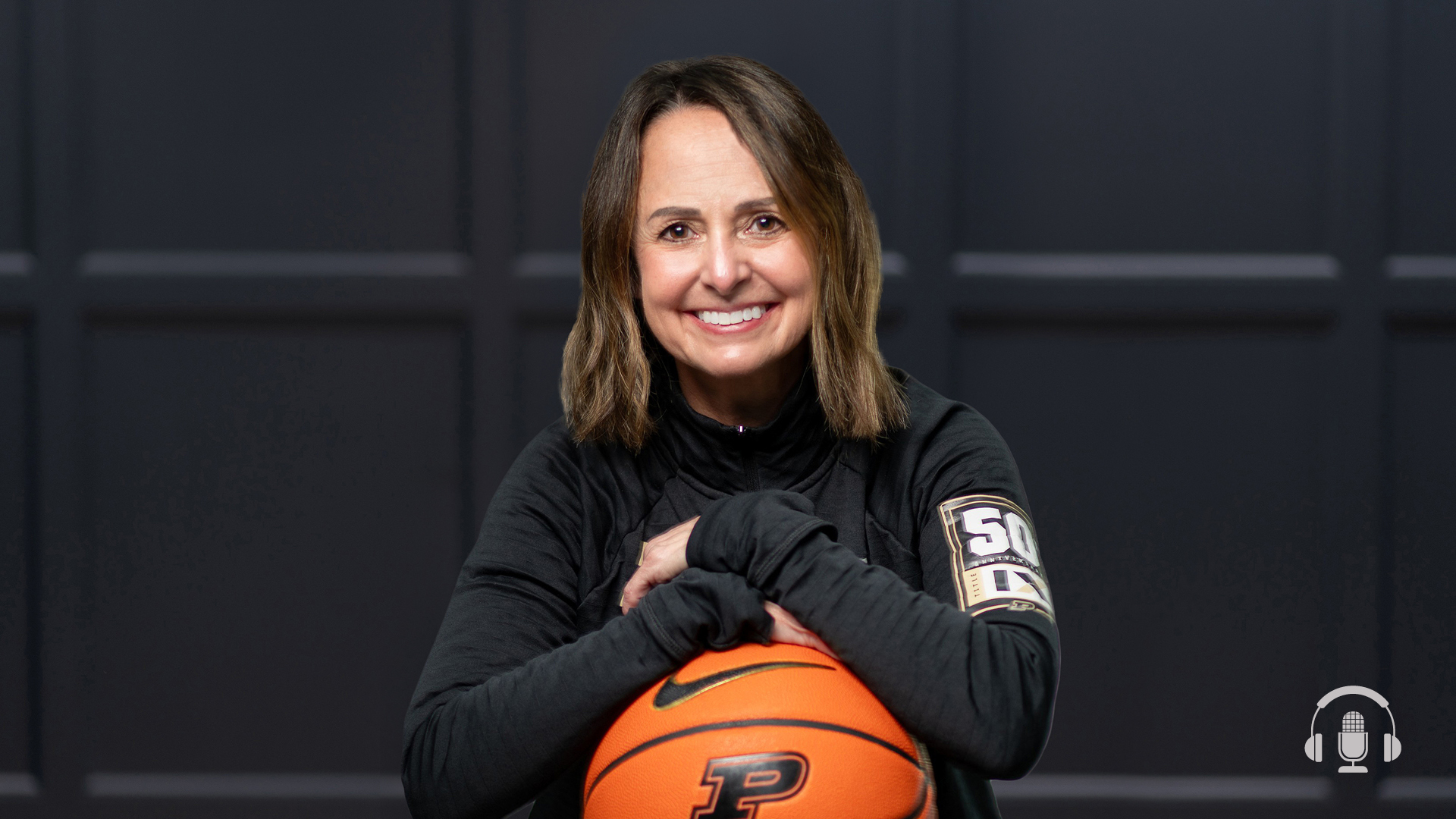Podcast Ep. 115: Purdue Research Series | A Look Into Speech, Language and Hearing Sciences Innovations With Preeti Sivasankar
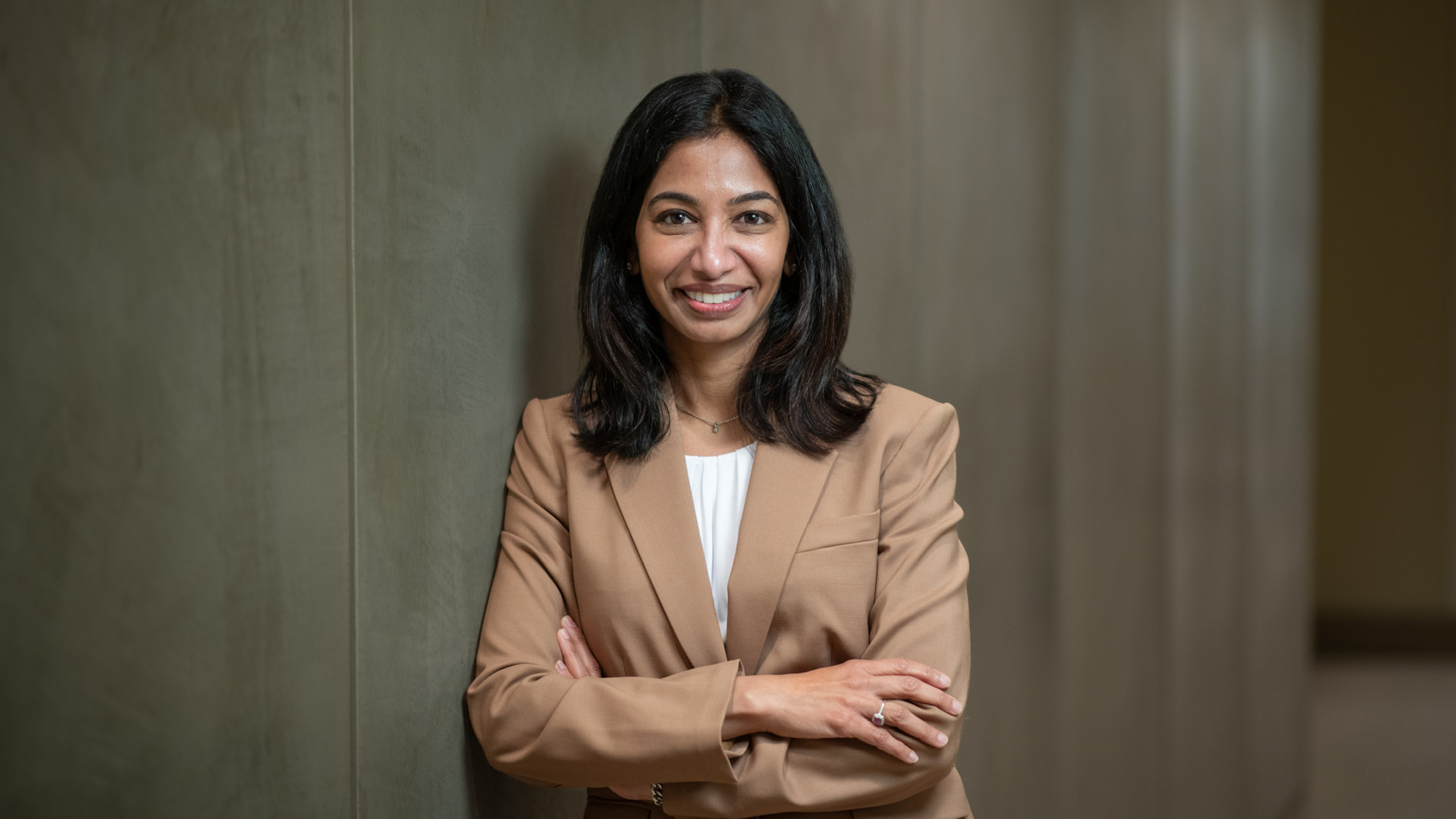
In this episode of “This Is Purdue,” we’re talking to Preeti Sivasankar, Purdue University’s vice president for research innovation and professor in the Department of Speech, Language, and Hearing Sciences.
Societal transformation begins with research, and no one knows this better than Preeti. Since joining Purdue’s faculty 19 years ago, she has contributed to making the department a leader in the field. Purdue is now home to the No. 2 speech-language pathology graduate program and No. 8 audiology graduate program in the country according to U.S. News & World Report. And as the newly appointed vice president for research innovation, she helps lead other Boilermaker researchers as their work continues to impact the world.
In this second episode of our 2024 Purdue Research Series, you will:
- Learn more about Preeti’s research in voice disorders, what causes them and how we can prevent vocal strain.
- Explore how Purdue’s Department of Speech, Language, and Hearing Sciences, part of the College of Health and Human Sciences, provides students and faculty with unique research opportunities and experiences.
- Discover how, as vice president of research innovation, Preeti’s approach to interdisciplinary research at Purdue will take our students’ and faculty’s work to the next level.
- Find out about the mentorship that’s shaping the next generation of researchers and making a significant impact in speech, language and hearing sciences.
- Hear her debunk common myths about saving our voices and describe what we can do to protect them.
You don’t want to miss this special episode with this persistent and boundary-pushing Boilermaker!
- Learn more about Preeti Sivasankar
- Learn more about the Department of Speech, Language, and Hearing Sciences
- Learn more about the College of Health and Human Sciences
- Learn more about the Office of Research
Podcast Transcript
Preeti Sivasankar:
This is Preeti Sivasankar, and you’re listening to This Is Purdue.
Kate Young:
Hi, I’m Kate Young, and you’re listening to This Is Purdue, the official podcast for Purdue University. As a Purdue alum and Indiana native, I know firsthand about the family of students and professors who are in it together, persistently pursuing and relentlessly rethinking. Who are the next game-changers, difference-makers, ceiling-breakers, innovators? Who are these Boilermakers? Join me as we feature students, faculty and alumni taking small steps toward their giant leaps and inspiring others to do the same
Preeti Sivasankar:
Research innovation is alive and well at Purdue. It’s something thousands of faculty and students are doing daily. And the question really is how do we continue to support research on campus, while at the same time really elevating the research enterprise?
Kate Young:
In this episode of This Is Purdue, we’re talking to Preeti Sivasankar, Purdue University’s Vice President for Research Innovation and Professor of Speech, Language, and Hearing Sciences. Societal transformation begins with research, and Preeti is at the heart of this when it comes to Speech, Language, and Hearing Sciences. Since joining Purdue’s faculty nearly 20 years ago, she has contributed to making Purdue a leader in the field, which is now home to the number two speech language pathology program and number eight audiology program in the country. In this second episode of our 2024 research series, you’ll hear more about Preeti’s research in voice disorders, what causes them, and how you can prevent vocal strain. Plus, we’ll explore how the Department of Speech, Language, and Hearing Sciences, part of Purdue’s College of Health and Human Sciences, provides students and faculty with unique research opportunities and experiences.
And, as the recently appointed Vice President for Research Innovation, Preeti shares how she helps lead other Boilermaker researchers as their work continues to impact the world. And by the way, stay tuned for the very end of this episode as our podcast team asks Preeti about listening to the sound of your own voice. Let me guess. Did you just cringe? I know, I know. Most people really dislike hearing the sound of their own voices, but did you know there’s actually a scientific explanation for why this is? Preeti explains it all in this episode. Okay, let’s get to it. Here’s my conversation with Preeti.
Preeti, thank you so much for joining us on This Is Purdue. First and foremost, congratulations on your newest appointment. We’re so excited for you. You are the Vice President of Research Innovation. We all know research is extremely important to Purdue and our identity here. So, what does research innovation mean to you and how will you continue to foster it here at Purdue?
Preeti Sivasankar:
Well, thank you, Kate. It’s just a real pleasure to be part of this podcast. So to me, research innovation is activity, scholarly and creative activity, that has high impact. To me, research innovation is work that transforms society, that increases society’s knowledge, but it doesn’t necessarily have to be translational. It spans bench to bedside, really basic work to work that can be immediately applied. It spans all disciplines: business, humanities to social sciences, life and health sciences, through the physical and natural sciences. I also think of research innovation as activity that can really support and boost the economy nationally and locally. And it’s really critical to our core mission of education, because of course at the end of the day, we are educating future researchers as well as consumers of research.
Kate Young:
Absolutely. And in your new role, you’ll help improve the university’s competitiveness for funding, and you’re also going to be building more research partnerships. What comes from that type of work?
Preeti Sivasankar:
To your first question, when you asked about continuing research innovation, I’m glad you said continuing, because research innovation is alive and well at Purdue. It’s something thousands of faculty and students are doing daily. And the question really is how do we continue to support research on campus while at the same time really elevating the research enterprise? And I think that happens from collaborations, building cohesive teams, looking ahead at what are going to be the next grand challenges, and really positioning ourselves as a university to address those challenges. So I think about it as collaborations with colleges in the office of the provost, with industry partnerships and commercialization, and global partnerships, just to name a few. But it’s also about the pipeline and it’s about supporting students, supporting early career faculty, to get ready for those larger competitive grants. The outcomes I see are multifold. They can be revolutionary technologies, new paradigms, rethinking established research mores and looking at whether they are still relevant, and other discoveries that can really transform society for the better.
Kate Young:
Absolutely. And speaking of that, the research being done here at Purdue impacts so many people, not only here in Indiana but also worldwide. What initially made you interested in a career in research?
Preeti Sivasankar:
I was trained as a speech language pathologist, so I was trained to provide behavioral intervention for individuals across the lifespan who have communication challenges. And this is many, many years ago. But during my years of clinical service delivery, it struck me that intervention strategies wouldn’t work uniformly for different individuals, and you could never predict whom it would work for and whom it wouldn’t benefit. So that led me to really question whether our intervention strategies were driven by a knowledge of underlying mechanisms. So that got me really interested specifically in the voice box, the larynx, which is a sound source for production of speech. And thinking about what do we know about the larynx, what do we understand about the biology of voice production, in an attempt to have more effective interventions that could help individuals. So that was what really got me to start thinking about a research career and led me to pursue a PhD and then an academic career at Purdue.
Kate Young:
Preeti’s introduction to speech language pathology was a personal one. She shares more about how her father’s stutter and her mother’s vocal fatigue as a teacher influenced her career.
Preeti Sivasankar:
My introduction to the discipline was actually through my father. My father was stuttered, and he had undergone what was then called speech correction. So I knew very vaguely and broadly about the disciplines of speech and hearing, and that’s why I decided to pursue it. But then really early on, I was fascinated by the larynx, the voice box. And that was, as you pointed out, because my mother was a school teacher. School teachers have a very high risk for voice problems, in part driven by the need to speak for long periods of time, speaking loudly, and oftentimes in environments that are not very conducive for sound projection. It’s interesting because it’s not really considered when you think about architectural engineering of classrooms. But that aside, I was really fascinated by why some people had vocal fatigue and would get tired and why some others would not. And at that time, I thought the simple answer was understanding more about the biology of the larynx. Of course, it’s a more complicated question. But that was what really got me interested in the voice box and studying that for now over 30 years
Kate Young:
Now, Preeti is leading a multidisciplinary research team studying the environmental and biological factors that might influence why some people experience voice problems and others do not. Recently, you may have heard about famous singers like Jon Bon Jovi and Adele sharing their journeys with vocal cord injuries and fatigue after excessive voice use. And Preeti agrees that excessive voice use certainly can contribute to voice problems. She explains more.
Preeti Sivasankar:
That’s a difficult question to answer. And the answer is I honestly still don’t know yet. What we know is that it’s a combination of factors. We do know that excessive voice use does increase the risk for voice problems, and that’s no surprise. The vocal folds are vibrating hundreds of times per second when we speak. And if you think about the amount of time that we engage in communication and speaking every day, that really adds up. So we do know that voice use and excessive voice use can result in voice problems, but voice disorders are also multifactorial, so there are many causes for voice problems. We know that environmental pollutants, cigarette smoke, vaping, simple pollutants in the air, those can really change the biology of the vocal folds. They cause tissue inflammation, which then causes voice problems. So something like an environmental pathogen or pollutant, along with excessive voice use, could interface together for a voice problem.
So a lot of individuals will report changes in voice, more coughing, after they have reflux that can be triggered for multiple reasons. It really depends on each individual. So for some individuals, it might be dietary choices. For others, it can be the times at which they ingest their meals. But we know that reflux appears to really compromise the biology of the tissue. This has been something we’ve shown in our lab and others have shown this as well. That is something that speakers should be thoughtful about, especially if they see their voices change after a meal. We of course know that pollution, whether through vaping or through environmental pollutants, can really challenge the voice. And then of course, the fundamental conditions that affect voice quality are excessive voice use. So as and when, the ability to use microphones, so that you’re not straining the voice as much can be really helpful. Other studies have shown that warming up the vocal folds before an intensive voice use session, much like we warm up our muscles before we work out.
Kate Young:
Sure.
Preeti Sivasankar:
Something like that can be really beneficial as well.
Kate Young:
That’s interesting. Before I record podcasts, they say you shouldn’t eat a big lunch or something, right?
Preeti Sivasankar:
Yes. Yes, of course.
Kate Young:
And then hot water with lemon helps. The other thing I’ve learned is that I don’t record first thing in the morning.
Preeti Sivasankar:
Absolutely.
Kate Young:
I like to warm up my voice with different meetings and stuff, and then I’ll record at four o’clock in the afternoon.
Preeti Sivasankar:
Yeah, so we all have certain times of day when we think our voices are optimal, and that can really differ for each speaker as well. So I do think it’s helpful to think a little bit about what we like about our voices and when they sound most optimal to us as speakers, and then use those time periods to have the most or have the heaviest voice activity. It’s interesting that you mention the warm water, because you hear that universally.
Kate Young:
Yes. Is that even true?
Preeti Sivasankar:
Well, we know that the water you drink doesn’t get anywhere near the larynx or the vocal folds, because if it did, you would cough. One of the reasons we actually have vocal folds is to protect the lungs. We don’t want water entering the lungs. So when the water first touches the vocal folds, you cough in order to expel the water out. So this is really interesting and it’s something that’s fascinated me for decades now. Why do we feel better when we drink water? And I don’t know the answer. Part of it might just be a placebo effect.
Kate Young:
Yeah, like feeling hydrated.
Preeti Sivasankar:
Absolutely. Part of it is that of course when you drink water, the upper parts of your airway are hydrated, so there could be some sort of feedback loop, sensory receptors in that area. But at the end of the day, if you feel that something works for you, that’s great and we should keep doing it as long as it’s not detrimental to other aspects of communication.
Kate Young:
So speaking of what things you can do to help your voice, we have some great video content with Preeti on our podcast YouTube page. You heard me mention drinking hot water with lemon before recording a podcast, but what about chewing gum or whispering or using the humidifier? Preeti debunks the most common myths about what can help your voice and what makes no difference at all. So be sure to head over to our YouTube channel, youtube.com/@thisispurdue, to watch this clip. Preeti shares more about the success of Purdue’s speech and language pathology graduate programs, which are both ranked in the top 10 by US News and World Report. Our speech and language pathology graduate programs at Purdue are ranked in the top 10. Could you elaborate on the ways that you and your colleagues support people of all ages in enhancing these speech language pathology skills?
Preeti Sivasankar:
I’m glad you asked because the 2024 rankings just came out last month, and we have actually climbed our rankings now by one spot each. So our speech language pathology program is now ranked number two in the country.
Kate Young:
Wow.
Preeti Sivasankar:
And our audiology program is ranked number eight.
Kate Young:
That is exciting.
Preeti Sivasankar:
Thank you.
Kate Young:
Congratulations.
Preeti Sivasankar:
It’s a real testament to the contributions of our faculty and staff. We are really dedicated to our mission of stellar clinical education, and that covers many aspects of how we provide clinical education and how thoughtful we are about the courses we offer in the clinics as well as in the classroom. So some examples, of course, are that our students are always with clinical faculty as they’re learning about how to provide clinical service. They’re deeply involved in understanding the underlying theory that drives these interventions. So all our clinical practice is really grounded in evidence, and that’s what makes it very effective. Our students are in the local community. We actually take our students to the local hospitals as well, so they work with local speech pathologists and audiologists. And in doing so, they can also bring discoveries that they learn in the classroom from the university directly to the community, and the community benefits from that as well.
Kate Young:
The Purdue masters and doctoral programs and speech language pathology and audiology are the only top 10 programs that aren’t attached to a university medical school. Preeti digs into what helps our Purdue programs remain competitive with others that have the benefit of an association with a medical school.
Preeti Sivasankar:
One of challenges of not having a medical school is that it can really compromise the quality of clinical education students receive, because they may not get access to the population or understand the needs that medically compromised patients have when they go to a hospital. So of course, that’s something we think about when we are planning our courses and our curriculum. And one of the ways we have addressed this as a department is we have our students go along with our faculty to the local hospitals. So our students go to IU Arnett, they go to Franciscan, they go to all the outpatient clinics in the community, and they are with our faculty who can really help them understand not only the healthcare environment, but how to navigate it for success.
And then of course our students, as part of the graduate coursework, do externships, and this can be anywhere in the 50 states. And the majority of students choose to do this in a healthcare or medical setting, so we really make sure that our students are getting that type of comprehensive education that will really set them up for success. That’s something that’s really important to the Department of Speech, Language, and Hearing Sciences.
Kate Young:
The Department of Speech, Language, and Hearing Sciences at Purdue is profoundly impactful because it addresses fundamental functions crucial to our quality of life. Preeti discusses how she and her colleagues support people of all ages in enhancing these essential skills. I want you to touch on, for our listeners and our viewers, that crucial quality of life. Hearing, speaking, swallowing, reading. Those are also important to all of us. So can you touch a little bit on what you all do when it comes to helping people with those potential issues that they might have?
Preeti Sivasankar:
Absolutely, Kate. So our expertise spans the lifespan, from infancy all the way through supporting elderly individuals communicate more effectively. So when you think about challenges that infants may have, those span trouble with hearing and trouble with feeding. So our students are trained to provide hearing intervention and therapeutic as well as feeding intervention. And then that goes through school aged kids who need support with reading and early literacy, speech and language therapy, or geological services. This is where interventions with fluency can come in as well as along with voice problems. And then we think about conditions that may impact communication as we enter occupations. So we think about occupational hazards from loud noise exposure, and of course audiologists interface with hearing conservation programs. We can think about voice problems from occupations that stress the vocal folds, so we are thinking about proactive voice treatments to prevent that, all through supporting healthy aging.
This involves interventions with balance so you can prevent falls, supporting safe swallowing to prevent aspiration, supporting effective communication, supporting strong cognition and memory, helping older individuals stay oriented, supporting their memory, attention, and so on so forth. So we really train our students to think about how we can be effectively serving society across the lifespan.
Kate Young:
Those were great examples. Is there anything else that our viewers and our listeners might not know about Speech, Language, and Hearing Sciences at Purdue? Why is this so pertinent to everyone in the world?
Preeti Sivasankar:
Speech, language, and hearing communication challenges, they don’t discriminate geographically. These are common conditions. They’re prevalent across the globe. What many individuals don’t recognize about our professions is that we support the lifespan. In fact, we even have freshmen in our major who’ve only interacted with the speech pathologists or audiologists in elementary school. So they don’t realize, in fact, what we can do and how we can support healthy aging. In fact, the Bureau of Labor Statistics predicts that speech pathology and audiology will be amongst the fastest-growing professions in the healthcare professions. They project that speech pathology employment is going to grow by 19% in the next 10 years, and for audiology, they project about 11% growth. So there clearly is an emerging need, especially as our population ages and we want them to age in a healthy way without compromising quality of life.
Kate Young:
What would you say would be happening if Purdue wasn’t doing this research?
Preeti Sivasankar:
Oh, gosh. I don’t even want to consider that situation. I just think communication is so fundamental. It’s about everything we do. And it’s not just verbal communication, it’s written communication and literacy. It’s communicating through sign language and gestures. It’s communicating with technology. And in fact, we think about Speech, Language, and Hearing Sciences as serving all individuals with communication challenges, so I don’t even want to conceptualize what it might be. In fact, I think what we need to do as a profession is really think about what those next challenges will be so we can really support our students to position themselves successfully for those challenges.
Kate Young:
You’ve been at Purdue for almost 20 years. What does the Boilermaker community mean to you? What role has Purdue had on your life?
Preeti Sivasankar:
Gosh, it’s about the people. It always has been, and it remains that way. I chose to come to Purdue 19 years ago because of the people I met in this department. I just felt that they would mentor me, that they would nurture me to success and support me. I’m getting goosebumps as I talk about people. But it’s really the reason I decided to come to Purdue, and this was 19 years ago. It’s the reason I decided to stay and that I’m still here. It’s a community that really advocates and sponsors others. It’s a community that believes in collective excellence, and I think this is exactly what we need, both from the research enterprise, but also from an educational mission. This is a community that’s always thinking about how we can do better and bigger things, and that’s really meaningful. So yeah, that’s one of the reasons I came and I have stayed.
Kate Young:
You’ve impacted, I’m sure, thousands of people with your research, with everything that you’re doing here at Purdue. What’s your favorite part of your research?
Preeti Sivasankar:
I’d say it’s really making a difference. It’s training students to be the next generation of researchers, seeing them really spark, light up, when we find something in the laboratory, whether that’s something we hypothesize or if it’s the opposite. So it’s really seeing that come alive. It’s seeing increased awareness of phenomena in the classroom, and I’m interacting with students. But as I have embraced leadership, both within the department but also now in the Office of Research, it’s really about making an impact. It’s about being able to advocate for others. It’s about empowering others to be their best and to be successful. There’s something very fulfilling about that, that’s just so very meaningful. The ability to lower barriers for others so that you can really elevate what they do, that’s just special. And that’s one of the reasons I have felt that strong leadership can be really very meaningful.
Kate Young:
What would you say your next giant leap is personally or professionally?
Preeti Sivasankar:
I’m really looking forward to supporting the Office of Research. We started with this question, and I really think this is just such a great environment for research excellence where we already are excellent, but we can do so much more to elevate all aspects of our research mission. And I think this position in the Office of Research really lends itself so well to that. So I’m looking forward to lowering barriers to faculty and students’ experience. I’m looking forward to enabling more clear communication, bringing together teams efficiently, streamlining some of our operations so we can really support the mission and really enable success across the board. To me, that would be really something that would be fulfilling, exciting, and I would hope would be of substantive impact across the Purdue community.
Kate Young:
Absolutely. I can tell you love your job and you’re very fulfilled.
Preeti Sivasankar:
Thank you.
Kate Young:
Well, we can’t thank you enough for joining us. Is there anything else you think that’s important to share with our listeners?
Preeti Sivasankar:
Yeah, I’m glad you asked. I think I probably shared 1% of what we do in the department of Speech, Language, and Hearing Sciences. And I know this podcast has broad viewership, so we’d love for students in this department to really be able to engage with our broader Purdue alumni network, for our students to learn about the scope of where alumni are and their successes, and also for other individuals to learn about what we do and why it’s so meaningful and why so many of us in this department do what we do. So anything that our alumni can do and viewers can do, visiting our website, we’d love for them to interact and meet with our students. And I think that would be a lot of fun for everyone in the unit.
Kate Young:
We will link that in our show notes.
Preeti Sivasankar:
Sounds good.
Kate Young:
It’s been a pleasure. Thank you so much for joining us.
Preeti Sivasankar:
Thank you, Kate.
Kate Young:
Okay, so I mentioned at the top of this episode that there’s a reason why most people cringe at the sound of their own voices. Our podcast team started discussing this phenomenon after we wrapped up our interview with Preeti, and we thought, why not ask the expert?
Okay, Preeti. This is behind the scenes, but as we’re working to tear down here, it’s a burning question we’re all wondering. I don’t know anyone that loves the sound of their own voice. Tell us why that is.
Preeti Sivasankar:
You can add me to that list. So, when we hear ourselves, it’s through bone conduction because we are hearing ourselves and our sound through the bones as they radiate the sound back, the bones of the skull. Versus when we hear ourselves later, it’s through air conduction, because we are hearing the sound through the air as it propagates to our ears. So it’s a very different mode of the sound being sent, and that’s why it sounds different.
Kate Young:
So, how do people hear us?
Preeti Sivasankar:
It’s through the latter. It’s through that air conduction mechanism when the sound is propagated through the air, so that’s how others hear us.
Kate Young:
And so when you’re listening to yourself on a recording, that’s how others are going to hear us?
Preeti Sivasankar:
Pretty much. You sound great, Kate, by the way.
Kate Young:
Thank you. Thank you. Thank you, Preeti. At this point, I really don’t even flinch listening back to my own voice. It comes with the territory now, I guess. We can’t thank Preeti enough for her time. She instills the Boilermaker spirit. Humble, kind, and persistent. Remember, you can check out our This Is Purdue YouTube page to see more behind the scenes video clips with Preeti. If you are a teacher, a musician, or someone who just uses their voice a lot, maybe even a podcast host, Preeti shares the three things you can do to protect your voice on our podcast YouTube page. And of course, be sure to follow This Is Purdue on Apple Podcasts, Spotify, iHeartRadio, or wherever you get your podcasts. This Is Purdue is hosted and written by me, Kate Young. Our podcast videography for this episode was led by Ted Schellenberger, in collaboration with Thad Boone, John Garcia, Zach Mogensen, and Alli Chaney.
Our social media marketing is led by Maria Welch. Our podcast distribution strategy is led by Teresa Walker and Carly Eastman. Our podcast design is led by Caitlin Freeville. Our podcast photography is led by John Underwood. Our podcast team, project manager is Rain Gu. Our podcast YouTube promotions is managed by Kirsten Bouman. Additional writing and research assistance is led by Sophie Ritz. And our This Is Purdue intern is Caroline Kime. Thanks for listening to This Is Purdue. For more information on this episode, visit our website at purdue.edu/podcast. There, you can head over to your favorite podcast app to subscribe and leave us a review. And as always, boiler up.
